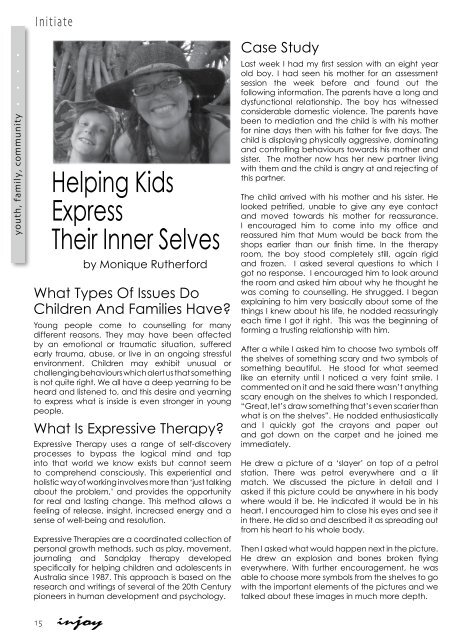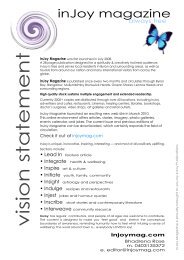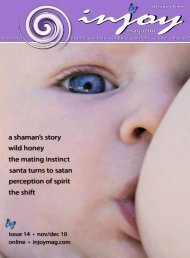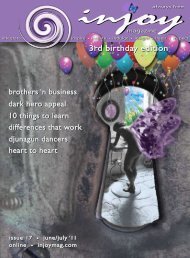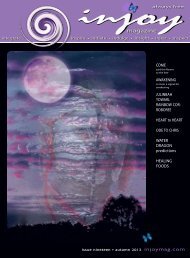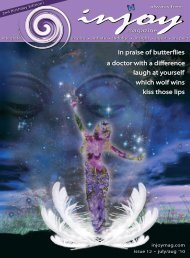Create successful ePaper yourself
Turn your PDF publications into a flip-book with our unique Google optimized e-Paper software.
youth, family, community • • • •<br />
Initiate<br />
What Types Of <strong>Issue</strong>s Do<br />
Children And Families Have?<br />
Young people come to counselling for many<br />
different reasons. They may have been affected<br />
by an emotional or traumatic situation, suffered<br />
early trauma, abuse, or live in an ongoing stressful<br />
environment. Children may exhibit unusual or<br />
challenging behaviours which alert us that something<br />
is not quite right. We all have a deep yearning to be<br />
heard and listened to, and this desire and yearning<br />
to express what is inside is even stronger in young<br />
people.<br />
What Is Expressive Therapy?<br />
Expressive Therapy uses a range of self-discovery<br />
processes to bypass the logical mind and tap<br />
into that world we know exists but cannot seem<br />
to comprehend consciously. This experiential and<br />
holistic way of working involves more than ‘just talking<br />
about the problem,’ and provides the opportunity<br />
for real and lasting change. This method allows a<br />
feeling of release, insight, increased energy and a<br />
sense of well-being and resolution.<br />
Expressive Therapies are a coordinated collection of<br />
personal growth methods, such as play, movement,<br />
journaling and Sandplay therapy developed<br />
specifically for helping children and adolescents in<br />
Australia since 1987. This approach is based on the<br />
research and writings of several of the 20th Century<br />
pioneers in human development and psychology.<br />
15<br />
Helping Kids<br />
Express<br />
Their Inner Selves<br />
injoy injoy<br />
by Monique Rutherford<br />
Case Study<br />
Last week I had my first session with an eight year<br />
old boy. I had seen his mother for an assessment<br />
session the week before and found out the<br />
following information. The parents have a long and<br />
dysfunctional relationship. The boy has witnessed<br />
considerable domestic violence. The parents have<br />
been to mediation and the child is with his mother<br />
for nine days then with his father for five days. The<br />
child is displaying physically aggressive, dominating<br />
and controlling behaviours towards his mother and<br />
sister. The mother now has her new partner living<br />
with them and the child is angry at and rejecting of<br />
this partner.<br />
The child arrived with his mother and his sister. He<br />
looked petrified, unable to give any eye contact<br />
and moved towards his mother for reassurance.<br />
I encouraged him to come into my office and<br />
reassured him that Mum would be back from the<br />
shops earlier than our finish time. In the therapy<br />
room, the boy stood completely still, again rigid<br />
and frozen. I asked several questions to which I<br />
got no response. I encouraged him to look around<br />
the room and asked him about why he thought he<br />
was coming to counselling. He shrugged. I began<br />
explaining to him very basically about some of the<br />
things I knew about his life, he nodded reassuringly<br />
each time I got it right. This was the beginning of<br />
forming a trusting relationship with him.<br />
After a while I asked him to choose two symbols off<br />
the shelves of something scary and two symbols of<br />
something beautiful. He stood for what seemed<br />
like an eternity until I noticed a very faint smile. I<br />
commented on it and he said there wasn’t anything<br />
scary enough on the shelves to which I responded,<br />
“Great, let’s draw something that’s even scarier than<br />
what is on the shelves”. He nodded enthusiastically<br />
and I quickly got the crayons and paper out<br />
and got down on the carpet and he joined me<br />
immediately.<br />
He drew a picture of a ‘slayer’ on top of a petrol<br />
station. There was petrol everywhere and a lit<br />
match. We discussed the picture in detail and I<br />
asked if this picture could be anywhere in his body<br />
where would it be. He indicated it would be in his<br />
heart. I encouraged him to close his eyes and see it<br />
in there. He did so and described it as spreading out<br />
from his heart to his whole body.<br />
Then I asked what would happen next in the picture.<br />
He drew an explosion and bones broken flying<br />
everywhere. With further encouragement, he was<br />
able to choose more symbols from the shelves to go<br />
with the important elements of the pictures and we<br />
talked about these images in much more depth.


